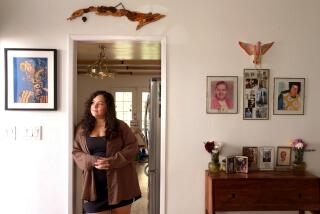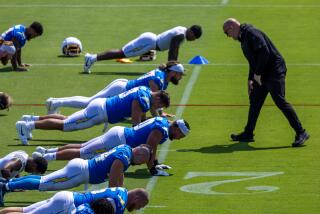‘Boot Camp’ Gives Wannabe Pro Wrestlers a Leg Up
- Share via
HAYWARD, Calif. — In a nondescript warehouse on the edge of the San Francisco Bay, the future of pro wrestling is getting body-slammed, clotheslined and pile drivered--or is that pile driven?
From buffed-out bodybuilders to skinny kids with a dream, the young wrestlers cavort in a ring, practicing moves designed to wow spectators and minimize actual pain.
This is the All Pro Wrestling Boot Camp, where wannabe “Stone Cold” Steve Austins and “Hollywood” Hulk Hogans are learning the finer points of the, er, sport.
“A lot of my friends say it’s fake, but it still hurts,” said 22-year-old student James Choi.
The two-year program, which costs $6,000, weeds out the avid Monday night wrestling viewers who think, “I can do that.” Only a lucky few make it to the final bell.
“We have a lot of people who walk through the door, and they think they’ll pay a fee and there’s a table that says ‘gimmicks’ and then there’s another that says ‘nicknames.’ They think that’s all there is to it,” Boot Camp founder Roland Alexander said. “The people I look for are the ones who love pro wrestling.”
The Boot Camp, and about two dozen similar schools around the country, are the minor leagues of pro wrestling.
Graduates perform in regional shows, developing their characters while vying for a tryout with one of the major leagues: the World Wrestling Federation or World Championship Wrestling.
Two graduates have made it that far, “Vicious” Vic Grimes and Erin “The Leprechaun” O’Grady. Both currently train in Tennessee.
“There are no shortcuts to anything in life,” Alexander said. “If you want to be a doctor, it takes time and study and years in school.” He called wrestling “a complex art form.”
Alexander left a $50,000-a-year job as an accountant and started his school in 1991. But those were tough times for pro wrestling. There was talk about steroid abuse, and some promoters admitted that matches were “predetermined.”
Strangely, once everyone ‘fessed up that the fights were fixed, it turned out the audience didn’t care. They wanted to see the spectacle anyway.
Today, WWF and WCW matches are among the most popular shows on cable television and pay-per-view, drawing in viewers with cartoonish plot lines often pitting good characters against evil ones.
The soap opera-like skits provide a healthy dose of trash talk and sexual innuendo, punctuated by rock ‘n’ roll, fireworks and outrageous costumes. The actual wrestling sometimes seems like an afterthought.
In one Boot Camp drill, students jump off the corner ropes, flip in midair and crash on their backs in the center of the ring. There are audible groans as bodies hit the mat, bounce up, and drop again. Over and over.
Many criticized the in-your-face, anything-for-ratings style of the spectacle when pro wrestler Owen Hart died in a 70-foot fall during a pre-match stunt at a Kansas arena in May.
But the crowds keep coming, and the minor leaguers keep hoping.
“I know it sounds kind of corny, but I had a dream about being a wrestler about two or three years ago,” said camper Mike Phillips, who has bleached hair and wears a Batman T-shirt. “Ever since then, that’s what I’ve wanted to do.”
Manuel Galindo, 24, commutes two hours from West Sacramento to attend class, where he practices such moves as the hip-toss, the turning arm-bar and the headlock.
“I feel I’ve got what it takes to do it,” he said.
More to Read
Go beyond the scoreboard
Get the latest on L.A.'s teams in the daily Sports Report newsletter.
You may occasionally receive promotional content from the Los Angeles Times.










